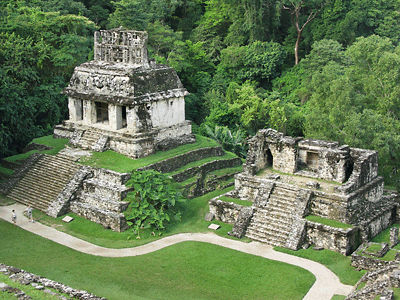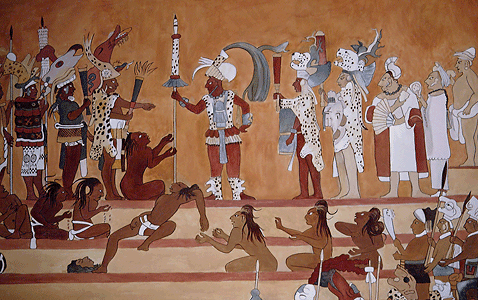Drought Doomed Ancient Maya
Wednesday, November 14th, 2012November 14, 2012
A catastrophic drought lasting nearly 100 years caused the downfall of the Maya in Central America more than 1,000 years ago, according to a new report by climate researchers led by Douglas Kennett of Pennsylvania State University. Archaeologists have long thought that climate change in the form of long drought was a factor in the collapse of the Maya, but detailed climate information was difficult to find in the archaeological record.

Ruins of an ancient Maya temple stand at Palenque in the state of Chiapas. The temple was built about A.D. 650, during a period when great indigenous (native) civilizations thrived in Mexico. (© Ales Liska, Shutterstock)
The Maya developed a magnificent civilization in Central America and south Mexico that reached its peak from about A.D. 250 to 900. During that time, known as the Classic Period, the Maya civilization was centered in the tropical rain forest of the lowlands of what is now northern Guatemala. Then, beginning in the 800′s, the Maya abandoned their major cities in the lowlands one by one and finally abandoned most of this region. Archaeologists have no clear explanation for why the Classical Maya civilization, known for its remarkable architecture, painting, sculpture, advancements in astronomy, and an accurate yearly calendar, collapsed so dramatically.
Kennett and his team were able to obtain detailed evidence about rainfall by measuring oxygen isotope levels in a stalagmite, a stone formation that rises up from the floors of caves, from a site in southern Belize. (Different isotopes [forms] of a chemical element, such as oxygen, contain different amounts of matter in the nucleus [core] of their atoms.) Stalagmites form when water, dripping on the floor from the walls and roofs of the cave, carries with it deposits of calcium carbonate, or calcite. Rainfall in a region can be calculated and linked to specific dates by measuring the ratio of radioactive oxygen isotopes in the layers of a stalagmite. The analysis by Kennett’s team indicated a long-lasting, severe drought from 660 to 1000 A.D., which corresponds to the collapse of Classical Maya civilization. The period of drought apparently intensified other factors, including overpopulation, disease, exhaustion of natural resources, and warfare, to bring an end to the Classical Maya civilization.

A Mayan mural depicts a scene at the royal court at Bonampak, where the king (center) is presented with prisoners captured in battle. Defeated rulers and other important prisoners of war were sacrificed to the gods in religious ceremonies. This restored mural was painted toward the end of the Classic Period, around 790 A.D., as rival cities in the Mayan civilization began to fight each other. (© Della Zuana Pascal, Sygma/Corbis)
However, the culture of the Maya never really disappeared. Today, descendants of the Maya still live in Mexico and Central America. They speak Maya languages and carry on many customs of their ancestors.
Additional World Book articles:


